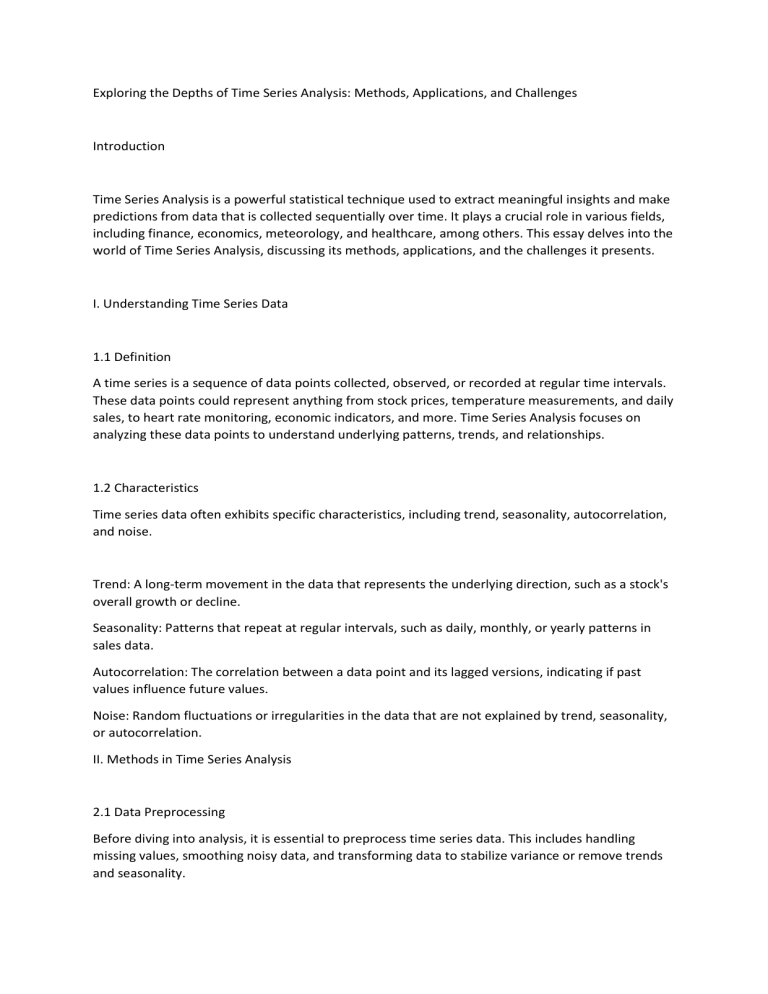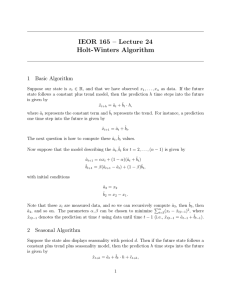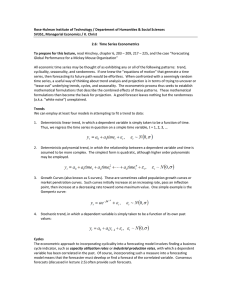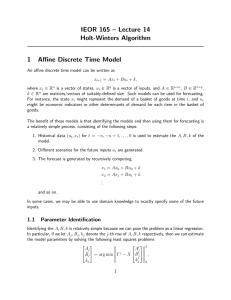Uploaded by
My Personal Tumbal
Time Series Analysis: Methods, Applications, & Challenges
advertisement

Exploring the Depths of Time Series Analysis: Methods, Applications, and Challenges Introduction Time Series Analysis is a powerful statistical technique used to extract meaningful insights and make predictions from data that is collected sequentially over time. It plays a crucial role in various fields, including finance, economics, meteorology, and healthcare, among others. This essay delves into the world of Time Series Analysis, discussing its methods, applications, and the challenges it presents. I. Understanding Time Series Data 1.1 Definition A time series is a sequence of data points collected, observed, or recorded at regular time intervals. These data points could represent anything from stock prices, temperature measurements, and daily sales, to heart rate monitoring, economic indicators, and more. Time Series Analysis focuses on analyzing these data points to understand underlying patterns, trends, and relationships. 1.2 Characteristics Time series data often exhibits specific characteristics, including trend, seasonality, autocorrelation, and noise. Trend: A long-term movement in the data that represents the underlying direction, such as a stock's overall growth or decline. Seasonality: Patterns that repeat at regular intervals, such as daily, monthly, or yearly patterns in sales data. Autocorrelation: The correlation between a data point and its lagged versions, indicating if past values influence future values. Noise: Random fluctuations or irregularities in the data that are not explained by trend, seasonality, or autocorrelation. II. Methods in Time Series Analysis 2.1 Data Preprocessing Before diving into analysis, it is essential to preprocess time series data. This includes handling missing values, smoothing noisy data, and transforming data to stabilize variance or remove trends and seasonality. 2.2 Visualization Visualization tools, such as line plots, scatter plots, and autocorrelation plots, help analysts gain an initial understanding of the data's structure and identify potential patterns. 2.3 Decomposition Decomposing a time series into its constituent parts (trend, seasonality, and residual) simplifies analysis and provides insights into the underlying patterns. Common methods include additive and multiplicative decomposition. 2.4 Statistical Models Various statistical models, such as Autoregressive Integrated Moving Average (ARIMA) and Exponential Smoothing, are employed to capture and forecast time series data. Machine learning techniques like Long Short-Term Memory (LSTM) networks and Prophet have gained popularity for their ability to handle complex relationships. 2.5 Model Evaluation Selecting an appropriate model requires rigorous evaluation using metrics like Mean Absolute Error (MAE), Mean Squared Error (MSE), and root mean squared error (RMSE). Cross-validation techniques ensure model robustness. III. Applications of Time Series Analysis 3.1 Finance Time series analysis is widely used in finance for stock market forecasting, portfolio optimization, risk assessment, and algorithmic trading. It aids in understanding market trends, volatility, and the impact of news and events on asset prices. 3.2 Economics Economists use time series analysis to study economic indicators like GDP, inflation rates, and unemployment rates. It helps in forecasting economic trends, identifying business cycles, and making policy recommendations. 3.3 Healthcare Medical professionals leverage time series data for patient monitoring, disease outbreak prediction, and drug effectiveness analysis. Wearable devices and electronic health records provide valuable time series data for healthcare applications. 3.4 Environmental Sciences Meteorologists use time series analysis to predict weather patterns, analyze climate data, and understand the impact of climate change. Environmental monitoring stations generate vast time series datasets that are crucial for research. 3.5 Marketing Retailers and marketers use time series analysis to forecast demand, optimize pricing strategies, and plan inventory. It helps in understanding consumer behavior and optimizing marketing campaigns. IV. Challenges in Time Series Analysis 4.1 Noise and Outliers Time series data often contains noise and outliers, which can mislead analysis and predictions. Robust methods are needed to handle these issues effectively. 4.2 Non-stationarity Many time series data are non-stationary, meaning their statistical properties change over time. Analysts must transform or difference the data to achieve stationarity. 4.3 Model Complexity Choosing the right model and hyperparameters can be challenging, especially for complex datasets. Overfitting and underfitting are common issues that require careful consideration. 4.4 Big Data As data collection methods advance, time series datasets are growing larger and more complex. Handling big data requires scalable and efficient algorithms and tools. 4.5 Interpretability Interpreting the results of time series analysis, especially in machine learning models, can be challenging. Providing actionable insights to stakeholders is crucial. Conclusion Time Series Analysis is a versatile and indispensable tool for understanding, forecasting, and making informed decisions based on sequential data. Its methods, applications, and challenges make it a rich and evolving field that continues to contribute to various domains, from finance and healthcare to environmental sciences and marketing. As data collection technologies advance, Time Series Analysis will remain at the forefront of data-driven decision-making.








